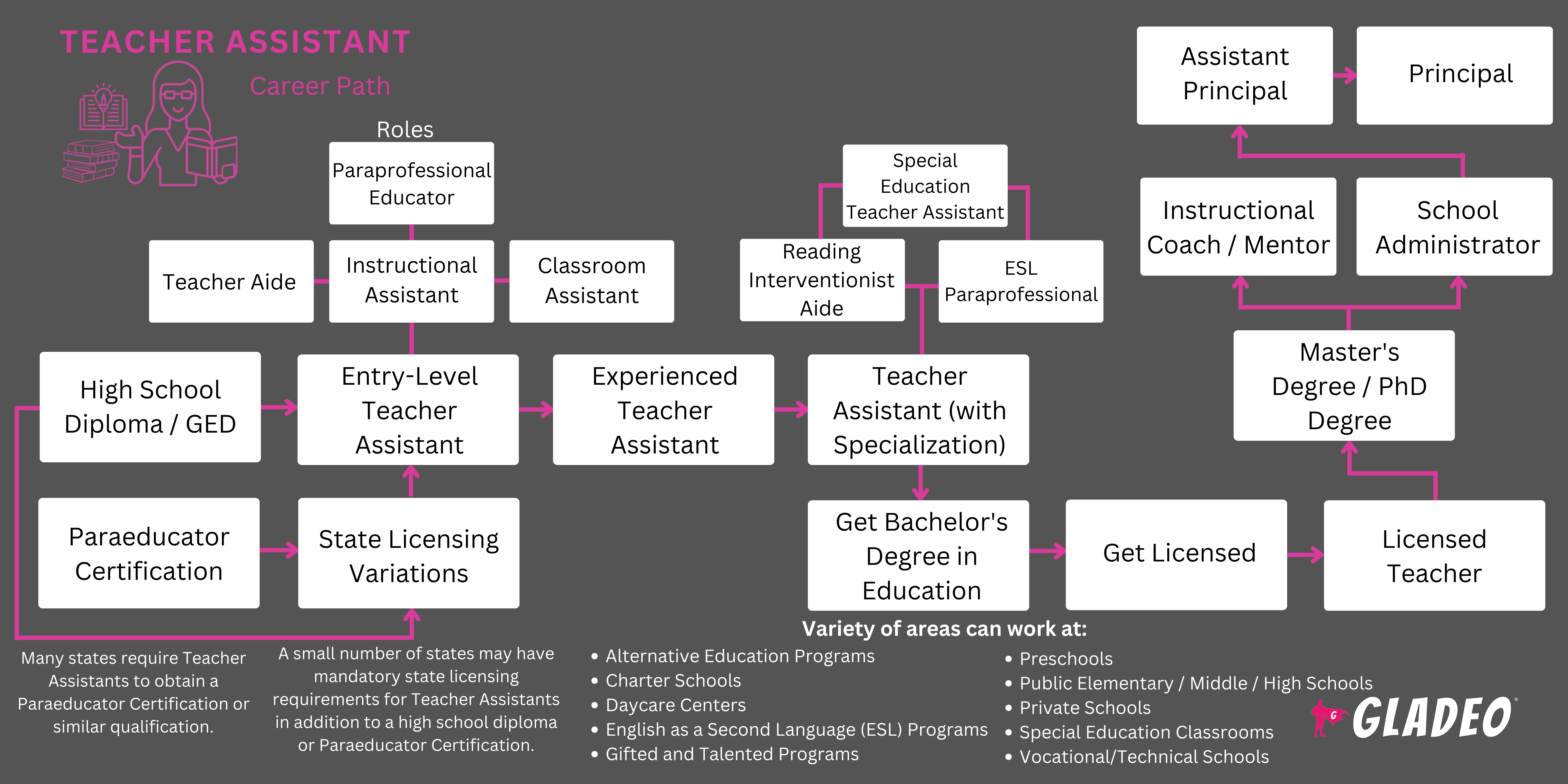Spotlights
Educational Assistant, Instructional Assistant, Paraeducator, Paraprofessional, Teacher Aide, Before/Afterschool Program Aide, Early Childhood Aide
Teachers have incredibly busy jobs, which is why many need help. A Teacher Assistant helps licensed teachers in a variety of ways. They act as classroom rule enforcers, modeling proper social skills while ensuring students stay well-behaved and on-task. They lend a hand preparing classrooms, setting up equipment, and getting materials ready for an upcoming lesson. They observe students and offer tutoring assistance to individuals and small groups during activities, answering questions, or giving guidance as needed.
Also known as paraprofessionals, teacher aides, instructional aides, or education assistants, they may be required to supervise students during periods outside of the classroom. Such times can include when students are roaming the halls, eating lunch in cafeterias, working out at the gym, or traveling during field trips. In addition, teacher assistants keep diligent records, offer their teacher supervisors insights into student needs and behaviors, and assist with lesson planning and development.
- Working with students and having a direct impact on their lives
- Helping to ensure students have a positive educational experience
- Playing a critical role in assisting those with unique needs
Working Schedule
A Teacher Assistant generally works between Monday through Friday; ~37% work part-time. Some may be in charge of supervising students on school buses during trips to and from school, which may extend duty hours.
During periods when school is out (i.e., summer and holiday breaks), there may not be work. However, certain teacher assistants do work year-round.
Typical Duties
- Assist teachers in the preparation of lesson and activity materials
- Organize activities aimed at developing specific skills
- Set up audio/visual or computer equipment
- Provide extra “eyes on” students during class
- Enforce classroom rules and model proper behavior
- Record student performance and offer insights to the teacher when necessary
- Keep track of attendance and assist with calculating grades
- Supervise students when the teacher is away, or when students are out of the classroom (i.e., in the halls, cafeterias, gym, at recess, or on field trips)
- Mentor individual students or assist small groups to offer personalized guidance with assigned tasks
- Offer additional support to students facing unique learning challenges
Additional Responsibilities
- Substitute during periods of the primary teacher’s absence
- Collaborate with peers on creating and improving student programs
- Work with teachers and parents to review student progress
- Help with meal preparation in daycares or preschool classrooms
- Assist children with basic skill acquisition
- Create a nurturing environment in which children can build skills
- Attend to basic needs (especially for young or special needs students)
Soft Skills
- Compassionate
- Composure
- Coordinating And Instructing Activities
- Creativity
- Decision-Making
- Desire And Aptitude To Help Others Succeed
- Empathetic
- Independent
- Leadership
- Monitoring
- Organization
- Patient
- Problem-Solving
- Resilience
- Resourcefulness
- Social And Cultural Awareness
- Sound Judgment
- Strong Communication Skills, Including Active Listening
- Teamwork
Technical Skills
- Social-emotional Learning (SEL) techniques
- CPR (certification often required)
- Inclusive practices
- Lesson planning
- General familiarity with computers (PC or Apple)
- Knowledge of visual presentation equipment (such as video magnifiers, televisions, etc.)
- Knowledge of printers, scanners, and photocopy equipment
- Microsoft Office, Google apps, Macintosh software
- Using various school database automation systems
- Familiarity with educational software designed for K-12 students
- Private and public schools
- Childcare centers
- Religious and volunteer organizations
Teacher Assistants are expected to support students and the lead teacher(s) as needed. Depending on the setting, the teacher assistant may work with one student in a full classroom or with a small group of students who may or may not have special needs.
The role requires someone who is dedicated to children and education. The person must pay attention to detail in assessing each student’s performance and ability, which will be shared with the teacher, administration, and parents as needed.
Teacher Assistants must exhibit high degrees of patience and enthusiasm while working in dynamic classroom environments. They are expected to model exemplary behavior at all times and maintain composure while addressing challenges such as inappropriate student behavior or emergency situations. They should be well-prepared for all planned lessons and activities, as well as unplanned contingencies. Teacher Assistants must be equipped to ensure the safety and well-being of the students they are tasked with watching over.
Becoming a fully licensed teacher can be a challenge. Many Teacher Assistants are interested in gaining exposure to the work conditions teachers face, before making a lengthy and perhaps expensive commitment to seek licensure in their state. Teacher assistants can gain practical background experience, which will serve them well if they decide to invest in the process of becoming a teacher.
After working as a Teacher Assistant, it is not uncommon for a person to decide that being a teacher is not the perfect fit for them. Others, however, will discover they do want to take the necessary steps to advance. Many are simply happy to remain as Teacher Assistants with lower wages than full teachers, but also less scope of responsibility.
The role of Teacher Assistants is evolving with the integration of technology in education. Current trends show an increasing reliance on digital tools, such as interactive learning platforms and virtual classrooms, to enhance student engagement and streamline administrative tasks. Assistants are expected to be proficient in using educational software, managing online resources, and supporting students in navigating digital learning environments.
Many enjoyed the learning experiences from their own K-12 days. They want to return to the classroom, but on the “other side” of things. Instead of being a student, they want to help mentor and nurture students this time around. Teacher Assistants tend to be active and lively, enjoy social interactions, and both mental and physical challenges.
They may have volunteered or worked as counselors, coaches, trainers, or care providers in a range of areas. Some have personal experiences helping those who grapple with learning disabilities. They come from diverse backgrounds and most have a strong desire to work towards cultural and socioeconomic improvements within the educational system and beyond.
- Education and training requirements vary based on state, school type, and personal career goals
- Public schools typically require two years of college or an associate’s degree, with courses in relevant areas
- Title 1 schools (i.e., those receiving federal funding) require a two-year college degree or applicable certificate, by federal mandate
- Private or charter schools may only require a high school diploma
- Applicable state licensure may be needed, and some positions require a paraeducator or paraprofessional certification
- Strong reading, math, and writing skills may be required, depending on the district
- CPR and/or First Aid certifications may be needed; these are required to be kept current
- Expect skills tests if working with special needs youth
- Awareness of and a commitment to diversity and equality in schools
- Internships, in some cases, can be helpful
- At least basic familiarity with computers, tablets, office software, and Internet research
- Familiarity with a second language is often beneficial
- Associate’s degree offerings in assistant teaching, paraprofessional education, early childhood development, or associated areas
- If your state requires additional certification, check to see if the associate’s program includes courses for that as well
- Consider specialization areas (such as special education), if offered and related to the career you want to pursue
- The school should be accredited, meaning it has undergone a quality assurance process to ensure it’s providing high caliber education
- Consider the cost of tuition, discounts, and local scholarship opportunities (in addition to federal aid)
- Think about your schedule and flexibility, when deciding whether to enroll in an on-campus, online, or hybrid program
There are over 200 Teacher Assistant programs currently available in the US, many of which are accredited and offered on-campus, online, or via hybrid courses where some coursework is done online.
Additional options include:
- National Association of Special Education Teachers - Paraprofessional Educator Certificate
- Special Educational Needs (SEN) Teaching Assistant training
- National Resource Center for Paraeducators, Related Service Providers, & Interveners training
- International Board of Credentialing and Continuing Education Standards - Autism Certificate
- Council for Professional Recognition - Child Development Associate
- High school teachers are often the perfect people to ask for guidance and mentorship
- Ask if your school offers opportunities to volunteer; any experience "behind-the-scenes" is beneficial to understanding teachers' daily routine and how the school operates
- If your high school offers them, consider taking courses that can help prepare you for future college courses related to pedagogy, developmental psychology, special education, assessment methods, and behavior management
- Hone up on your reading, math, and writing skills
- Expand your knowledge of concepts related to diversity and social justice standards within K-12 settings, as these are critical current topics
- Look for volunteer or paid opportunities outside the school, such as with youth organizations, religious activities, for-profit businesses, or other places where interaction with children is part of the role
- Network often and keep a list of contacts, including email addresses
- As you gain experience, find roles that demand you to exhibit leadership skills and perform duties with increased responsibilities and less oversight

- Document details of everything you do, for future use on your resume and/or college applications. A Word document or Google Doc is a great way to keep track of things (just make sure to keep a backup!)
- The more effort you’re able to put in during high school and college, the better your chances of having a great resume
- Check out online Teacher Assistants resume templates
- Use quantifiable results on your resume, when possible (data, statistics, and numbers, such as how many students you were responsible for in a role)
- In addition to courses taken and any volunteer or paid work you’ve done, make sure to list any other practical experience you have of working with children, including internships
- Stay connected to your network and ask for leads on upcoming job openings
- Stay up-to-date on the latest developments; things change quickly in the education world
- Apply for open positions found on Indeed.com, EdJoin.org, and other job-seeking sites
- Ask relevant network connections to write recommendation letters, or request their consent (in advance) to list them as references
- During interviews, demonstrate awareness of trends related to eLearning
- Clearly articulate your enthusiasm for working with youth and explain why you are the best candidate
- If you are contacted after an interview to provide references, do so and then give those references a heads-up so they can expect to be contacted
- Know how to dress for interview success!
- Extra education, training, certification, or licensure can lead to more opportunities
- Demonstrate sincere caring and compassion for children, with a focus on improving their educational progress
- Continue work towards a specialization area by taking advanced courses when ready
- Become the go-to expert on diversity and social justice standards
- Keep exploring opportunities in-and-out of the school, with an eye on building your reputation and experience with leadership, management, and oversight of events
- Grow your professional network and start mentoring others
- Join professional organizations and read relevant trade publications that will expand your awareness of topics
- Serve on high-visibility school and district committees and make an impression
- Polish your social and organizational skills to perfection
- Strengthen relationships with students, staff, teachers, and administrators
- Be a passionate advocate and mediator for students and student rights
- Build the trust of students, parents, and communities; stay aware of the range of issues affecting them
- Get creative! Learn fresh new ways to teach subjects and keep students motivated, such as eLearning, blended learning, flipped classrooms, and other techniques
- Join mailing lists of education centers and attend conferences and workshops
- Never stop learning new things!
Websites
- American Association on Intellectual and Developmental Disabilities
- American Educational Research Association
- American Federation of State, County and Municipal Employees
- American Federation of Teachers
- American Montessori Society
- Association for Early Learning Leaders
- Association for Middle Level Education
- Association of American Educators
- Association of Educational Therapists
- Association of Teacher Educators
- Association on Higher Education and Disability
- Autism Society
- Childhood Education International
- Council for Learning Disabilities
- Council for Professional Recognition
- International Association of Special Education
- International Board of Credentialing and Continuing Education Standards
- International Dyslexia Association
- Learning Disabilities Association of America
- Mid-South Educational Research Association
- Mid-Western Educational Research Association
- National Association for Bilingual Education
- National Association for Gifted Children
- National Association for the Education of Young Children
- National Association of Early Childhood Teacher Educators
- National Association of Special Education Teachers
- National Association of State Directors of Special Education
- National Education Association
- National Parent Teacher Association
- National Resource Center for Paraeducators
- Northeastern Educational Research Association
- Southeastern Association of Educational Opportunity Program Personnel
- Southern Early Childhood Association
- Southwest Educational Research Association
- Special Educational Needs (SEN) Teaching Assistant
- Teacher Education Division of the Council for Exceptional Children
- The Arc
Books
- AI in Education, by James Robert
- Powerful Teaching: Unleash the Science of Learning, by Pooja K. Agarwal and Patrice M. Bain
- The Psychology Of The Child, by Jean Piaget & Barbel Inhelder
Many Teacher Assistants go on to obtain licensure to become a full teacher. However, some find that the work isn’t an exact match for what they want out of their career. In addition to teaching, there are several related occupations to consider, such as the ones listed below!
- Academic Advisor
- Academic Researcher
- Admissions Counselor
- Career Counselor
- Childcare Worker
- Community Outreach Coordinator
- Content Strategist
- Corporate Trainer
- Curriculum Developer
- Customer Success Manager
- Educational Technologist
- Event Planner
- Human Resources Specialist
- Librarian
- Life Coach
- Museum Educator
- Occupational Therapy Assistant
- Parenting Coach
- Program Director for Nonprofit Organizations
- Public Relations Specialist
- Rehabilitation Counselor
- Social Worker
- Speech-Language Pathologist
- Talent Development Manager
- Technical Writer
- Tutor
- Volunteer Coordinator
- Youth Program Coordinator
Newsfeed

Featured Jobs

Online Courses and Tools

Annual Salary Expectations
New workers start around $0K. Median pay is $0K per year. Highly experienced workers can earn around $0K.





